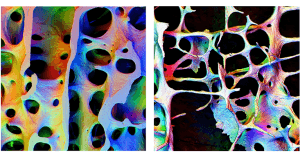Lewis A. Lipsitz in Nautilus:
 Simplicity, simplicity, simplicity!” Henry David Thoreau exhorted in his 1854 memoir Walden, in which he extolled the virtues of a “Spartan-like” life. Saint Thomas Aquinas preached that simplicity brings one closer to God. Isaac Newton believed it leads to truth. The process of simplification, we’re told, can illuminate beauty, strip away needless clutter and stress, and help us focus on what really matters. It can also be a sign of aging. Youthful health and vigor depend, in many ways, on complexity. Bones get strength from elaborate scaffolds of connective tissue. Mental acuity arises from interconnected webs of neurons. Even seemingly simple bodily functions like heartbeat rely on interacting networks of metabolic controls, signaling pathways, genetic switches, and circadian rhythms. As our bodies age, these anatomic structures and physiologic processes lose complexity, making them less resilient and ultimately leading to frailty and disease.
Simplicity, simplicity, simplicity!” Henry David Thoreau exhorted in his 1854 memoir Walden, in which he extolled the virtues of a “Spartan-like” life. Saint Thomas Aquinas preached that simplicity brings one closer to God. Isaac Newton believed it leads to truth. The process of simplification, we’re told, can illuminate beauty, strip away needless clutter and stress, and help us focus on what really matters. It can also be a sign of aging. Youthful health and vigor depend, in many ways, on complexity. Bones get strength from elaborate scaffolds of connective tissue. Mental acuity arises from interconnected webs of neurons. Even seemingly simple bodily functions like heartbeat rely on interacting networks of metabolic controls, signaling pathways, genetic switches, and circadian rhythms. As our bodies age, these anatomic structures and physiologic processes lose complexity, making them less resilient and ultimately leading to frailty and disease.
To understand this loss, we must first define what we mean by “complexity” in the scientific sense. Consider a Rube Goldberg machine, in which one action leads to another, then another, and so on in linear fashion to finally, say, scratch one’s back or bring a napkin to one’s mouth. Although this over-engineered contraption may look complicated, it’s actually quite simple: A given input always produces the same output. Its simplicity makes its behavior easy to predict. It also makes the system vulnerable because a single break in the chain will undermine its entire function. A complex process, in contrast, involves multiple different components interacting across multiple scales in time and space. Because these interactions are nonlinear, outputs are not proportional to inputs and thus are more erratic and unpredictable.
More here.
